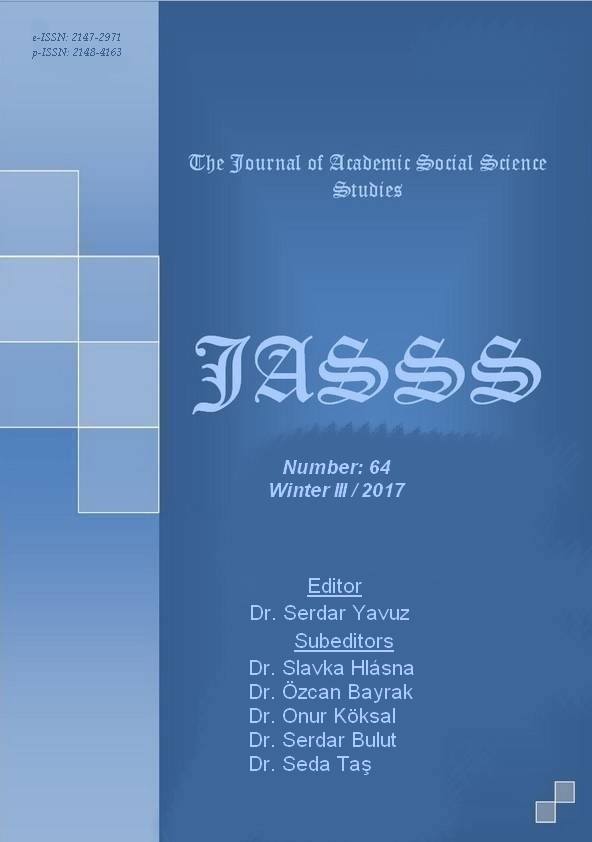Author :
Abstract
Posof ve çevresinde, tarihi Türk-İslam mezar taşı kültürünün önemli örnekleriyle karşılaşılır. Bu örnekler, formları, motifleri, ikonografik içerikleri bakımından değerlendirildiklerinde, geçmişten günümüze İslam inancının ve Türk kültürünün önemli ipuçlarını ortaya koymaktadırlar. Ardahan ve çevresinin, Kars ve çevresinin genelinde olduğu gibi Posof ve çevresinde de yaygın bir biçimde karşımıza çıkan soyut heykel formlu mezar taşları, İslamiyet öncesi heykel biçimli tarihi Türk mezar taşı geleneğinin islami kimliğe büründürülerek, surat ve vücut uzuvları soyutlanarak, geleneğin inanca uygun hale getirilip, devam ettirilişini göstermektedirler. Posof çevresindeki nüfusun çoğunluğunu oluşturan Ahıska kökenli Türklere ait mezar taşları, eski Türk heykel formlu mezar taşlarının çehre belirtilmeden ve diğer uzuvları soyutlanmış haliyle karşımıza çıkar. Bunların önemli örneklerinden bir gurubunu Eski Rabat Mezarlığı’nda ve Kayabaşı Mezarlığı’nda bulmak mümkündür. Ardahan’ın Posof ilçesine bağlı Eski Rabat Mahallesi mezarlığı, tarihi Türk mezar taşı geleneğinin önemli örneklerini sergilemektedir. Ancak, mezarların çoğu sandukasız olduğu için, daha kolay tahrip olmuş, sadece baş ve ayak şahideleri kalabilmiştir. Bunlardan biri, “La ilahe illallah Muhammedun Resulullah” yazıtı ile baş şahide taşının kaldığı, diğer unsurlarının kaybolduğu mezardır . Bu mezar da, Ardahan yöresinde yaygın olan, heykelsi kabir taşı geleneğini devam ettirmektedir. Başında papağı, biraz yüksek tutularak iki yandan profille “V” biçiminde yaka formu verilen silindirik boyun kısmı, geniş omuzları, her iki omuza işlenmiş madalyaları (gazilik madalyası veya askeri rütbe olabilir) ile soyut heykel biçiminde işlenmiştir. Tüm bu özellikler, bu şahide taşının rütbeli bir asker ya da bir gaziye ait mezardan kalmış olabilme ihtimalini kuvvetlendirmektedir. Posof İlçe merkezine bağlı Kayabaşı Mahallesi’nde bulunan ve Kayabaşı mezarlığı diye anılan mezarlıkta aşırı soyutlanmış olsalar da, Orta ve İç Asya’daki sın taşı (geyik taşı) ve balbal tarzı heykel geleneğini yansıtan mezar taşı örnekleri bulunmaktadır. Kaynağı Orta ve İç Asya’daki İslamiyet öncesi inançlara göre yapılmış sın taşları (geyik taşı) ve balballara kadar uzanan, İslam İnancıyla birlikte Anadolulu kimlik kazanan, başta çehre olmak üzere vücudun suret veren uzuvlarının soyutlanmasıyla eski Türk mezar taşı geleneğinin soyut insan heykeli formunda devam ettirildiği, Posof yöresi mezar taşları Türk-İslam inanç, kültür ve sanatının önemli örnekleridir. Yöredeki sözünü ettiğimiz soyut insan heykeli formlu mezar taşlarının kitabeleri okunup, motifleri dikkatlice analiz edildiğinde, bunların çoğunun asker, şehid ve din görevlisi mezarları olduğu, bazen de soylu ve lider kişilik vasfına sahip insanların mezarları olduğu anlaşılmaktadır.
Keywords
Abstract
Posof and its surroundings are encountered with important examples of historical Turkish-Islamic tombstone cultures. These examples reveal important clues of the past day-time Islamic belief and Turkish culture when they are evaluated in terms of their forms, motifs, and iconographic contents. As the Ardahan and its surroundings are in the whole of Kars and its environs, the abstract sculpture tombstones in the form of abstract sculpture, which are widely anticipated in Posof and its environs as well as the surroundings of Kars and its environs, are made up of the Islamic identity of the pre-Islamic sculptural historical Turkish gravestones, they are continuing. The tombstones of Ahiska origin Turks constituting the majority of population in the vicinity of Posof come out against the old tombstones in the form of Turkish sculptures, without the face and the other limbs being abstracted. It is possible to find a group of these important examples in the Old Rabat Cemetery and Kayabaşı Cemetery. Posof and its surroundings are encountered with important examples of historical Turkish-Islamic tombstone cultures. These examples reveal important clues of the past day-time Islamic belief and Turkish culture when they are evaluated in terms of their forms, motifs, and iconographic contents. As the Ardahan and its surroundings are in the whole of Kars and its environs, the abstract sculpture tombstones in the form of abstract sculpture, which are widely anticipated in Posof and its environs as well as the surroundings of Kars and its environs, are made up of the Islamic identity of the pre-Islamic sculptural historical Turkish gravestones, they are continuing. The tombstones of Ahiska origin Turks constituting the majority of population in the vicinity of Posof come out against the old tombstones in the form of Turkish sculptures, without the face and the other limbs being abstracted. It is possible to find a group of these important examples in the Old Rabat Cemetery and Kayabaşı Cemetery. The graveyard of the Old Rabat neighborhood connected to Ardahan's Posof district exhibits important examples of the historical Turkish gravestone tradition. However, since most of the tombs were without cisterns, they were more easily destroyed, and only the head and foot prophets could survive. One of these is the inscription of "La ilahe illallah Muhammaden Rasulullah", the headstone of the mausoleum, the other elements of which are lost. This grave continues the tradition of sculptural grave stone, which is widespread in the Ardahan region. The cylindrical neck, which is shaped like a profile "V" collar on both sides, is slightly tall at the head, and is processed in the form of an abstract sculpture with wide shoulders, medals on both shoulders (may be a veteran medal or military rank). All these features strengthen the likelihood that this wartime stone may have remained a grave soldier or a tomb belonging to a gazelle. Although they are extensively isolated in the cemetery called Kayabasi Cemetery in the Kayabaşı Quarter of the center of Posof District, there are examples of tombstones reflecting the tradition of sculpture and balbal style sculpture in Central and Central Asia. The origin of the ancient Turkish tombstone tradition continued in the form of abstract human sculpture with the abstractation of limestones made up according to pre-Islamic beliefs in the Middle and Central Asia, and extending to the balbalara, with the Islamic beliefs gaining an Anatolian identity, Posof region tombstones are important examples of Turkish-Islamic faith, culture and art. It is understood that when the inscriptions of the abstract human sculptured tombstones we read in the verse are read and the motifs are carefully analyzed, it is understood that they are graves of soldiers, martyrs and religious officers, and sometimes graves of noble and leader personality.





